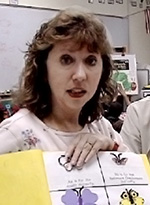Instructional Accommodations: Making the Learning Environment Accessible to Students with Visual Disabilities (Archived)
Wrap Up
Transcript: Wrap Up
In this module, you followed along with Ms. Milton as she learned how to include two students with visual impairments, Evan and Emily, in her general education classroom. Ms. Milton learned that the TVI, O&M specialist, student, parents, and the IEP are valuable resources for collecting information about the needs of a student with a visual disability. She also learned about different types of visual impairments—including impaired acuity and impaired visual fields. Ms. Milton discovered that the students needed not only to learn the standard curriculum but some additional skills that comprise the expanded core curriculum. When changing her instructional materials to more effectively teach Evan and Emily, she not only considered visual accommodations, but she also considered including tactile and auditory materials to appeal to the other senses. Ms. Milton also realized the importance of making changes to instructional presentations, classroom demonstrations, and audio-visual presentations to ensure students with vision impairments are able to learn alongside their sighted peers. She also discovered the importance of preparing for trips outside of the classroom. Finally, Ms. Milton learned tips on effective communication and how to facilitate the social integration of students with visual disabilities in a general education classroom. After learning about Evan’s and Emily’s visual disabilities and how to make changes to accommodate them, Ms. Milton now feels that she has the practical knowledge needed to successfully include them in her classroom.
Betty Hurst, a first-grade teacher in Nashville, Tennessee, had a student with a visual disability in her class several years ago. Listen as she describes her own experience teaching this student.

Transcript: Betty Hurst
I had never really worked with a child that was totally blind. I’d had a child many years ago that had lost one eye to cancer, and so he was considered legally blind. And I knew how to work with that type of vision child. But totally blind, I just really kind of had to adjust my thinking, go into another like left-brain area to pull some activities from my head. But it was kind of difficult at first to readjust some of my thinking, but not that bad. Because, you know, I felt like she needed to have her needs met just like everybody else. So I talked with the vision teacher some and, actually, just kind of felt my way through the year. But as the year progressed, by the two or three months, all nervousness was completely gone. It was a very comfortable setting. The children adapted to her very well, and she seemed to really pick up learning. And I didn’t want anybody to take my time away from her because that was so special to me.
Revisiting Initial Thoughts
Think back to your initial responses to the following questions. After working through the resources in this module, do you agree with your Initial Thoughts? If not, what aspects of your answers would you change?
What does Ms. Milton need to know about students with visual impairments?
What should Ms. Milton consider when creating lesson plans to ensure the inclusion of Evan and Emily?
How can Ms. Milton facilitate Evan’s and Emily’s social adjustment?
When you are ready, proceed to the Assessment section.
To learn more about collaborating with the TVI, the Orientation and Mobility specialist, and paraprofessionals, visit the IRIS Module:
To learn more about making the classroom accessible for students with visual impairments, visit the IRIS Module: